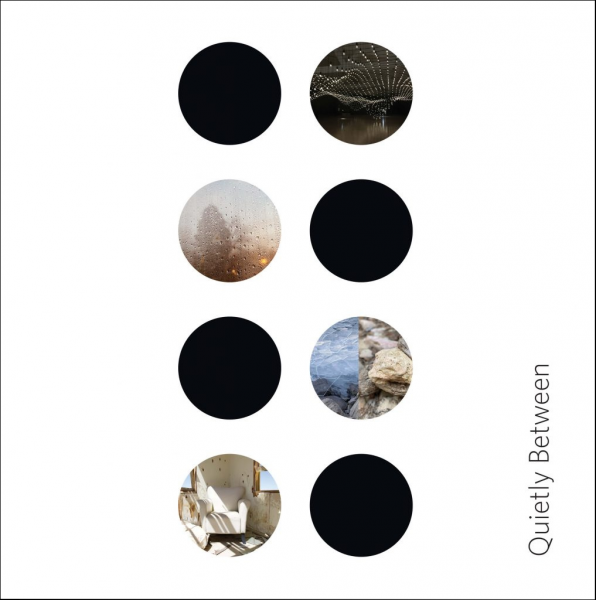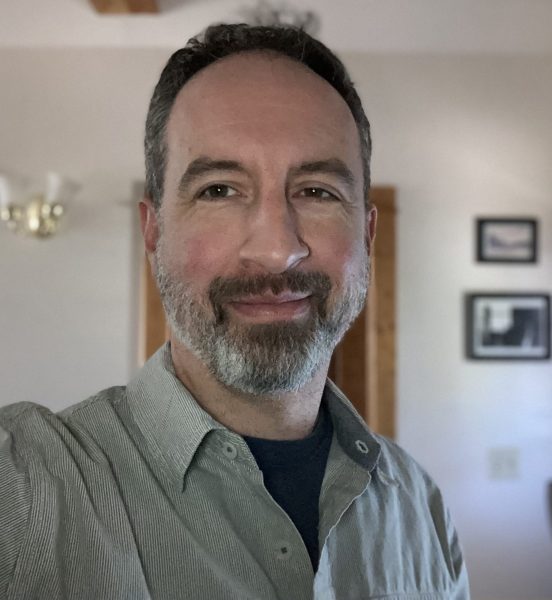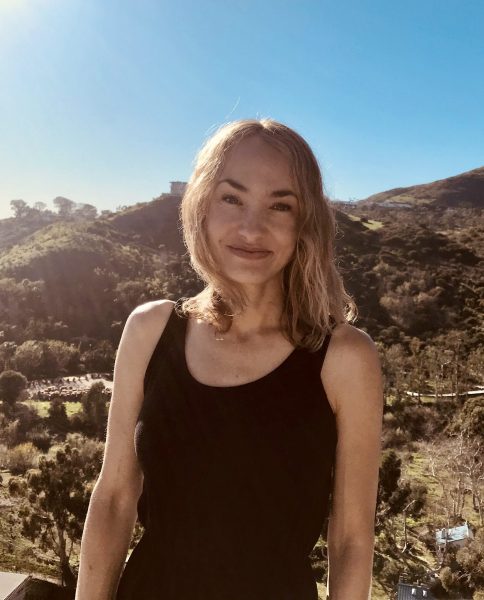A major reason students pursue an MFA in Creative Writing at CSU is our community. As many will attest, there’s really nothing like the supportive environment you’ll find within your cohort. But if you’re looking for another catalyst, consider the connections you’ll make along the way with future and past alumni. Such friendships may just lead to exciting possibilities you never imagined. Just ask Brad Vogler, who graduated from the program in 2011, and Sarah Green, who is currently finishing her thesis.
To backtrack: In the winter of 2017, Vogler and Green met at a poetry reading at The Forge in Fort Collins and became friends. Even after Green moved from Colorado to California, the pair stayed in touch, bouncing ideas off one another and discussing prompts to spur their poetry forward. What they didn’t know back then is that years later they would forge their own poetry together in the form of a new collaborative endeavor known as A Viewing Space.
The project developed in 2020, out of a series of conversations between the two poets about place—how our sense of space and time informs our experience of being in the world—and their desire to explore these elements through creative practice. As a platform, Vogler and Green hope A Viewing Space will facilitate ongoing engagement with kindred investigations and the publication of various textual and visual projects.
Published at the end of 2022, the first book in the series, Quietly Between, is a collection of poetry and photography and includes work from Megan Kaminski, Lori Anderson Moseman, Vogler and Green.
Read on for an in-depth conversation between Vogler, Green, and Department of English Communications Coordinator Emily Harnden about A Viewing Space, the craft behind Quietly Between, and the connection between place and poetry.
EH: How did you both dream up A Viewing Space? In what direction(s) do you see it expanding?
BV: Back in 2020, when traveling wasn’t an easy option, we started talking about a project the two of us could do that involved our current places. Sarah was in Joshua Tree, and I was in Fort Collins. Sarah had wanted to photograph the area she was living in, and as we talked, we put down some notes for a prompt we could begin working from.
I have ideas for a few other books, a place-based nonfiction series that would be similar to Kim Stringfellow’s Jackrabbit Homestead. Sarah had shared Jackrabbit Homestead with me, and I enjoyed the personal elements to the history in Stringfellow’s essay. I think it would be interesting to do something like that, 50 or so pages in length, where people investigated their place through writing and photographs. Our first project is this book, and we are both in it, but we are keeping things open to investigate place through a variety of visual and textual experiments.
SG: This project was very much born out of the pandemic. Our initial conversations revolved around how we could take advantage of what was a highly unusual situation—all of us being confined to our particular places—and turn it into an opportunity to explore those places in greater depth.
I’d been inspired by how people from all over the world were sharing sketches and photos of the view outside their windows–how this common frame illustrated what a universal situation we were in, despite otherwise vast distances and cultures. The commonality of everyone’s spaces struck me, while simultaneously drawing attention to the minute details that made them stand apart. That one branch or building you glance at everyday might have never seemed remarkable, but now it’s become the focal point. It reminded me that we could find significance in even the most mundane place or situation if we really paid attention to it. This project enabled me to transform an otherwise constrictive experience into an expansive one. I was enthralled with the landscape of the desert, and already taking photos, so the idea of having each of us document our spaces in both image and text seemed an ideal way of depicting an element of both the physical and psychic spaces we were inhabiting.
EH: How would you describe your first book in the project, Quietly Between, to readers?
BV: Quietly Between collects the poetry and photography of four authors, Megan Kaminski, Lori Anderson Moseman, Sarah Green, and myself. Each of us began our work with the same prompt that focused on place and time. The prompt is intentionally open to encourage exploration. When I designed the book, I laid out each page spread to contain a photo and the corresponding poem. I wanted to provide the reader a single place of encounter. All of the photos were made into postcards, and each of us had three sets to mail out.
SG: I’d say that beyond the final collection of photos and poems, it was an experiment in integrating art into our daily lives, and turning our lives into art.
EH: As you’ve said, Quietly Between begins with a prompt—what influenced this decision, and why was it important for the project to start out as interpretive?
BV: Starting with a prompt, and collecting the work from multiple writers, was something I’ve wanted to do for a long time. Providing a guide and allowing each person to work from that opened things up in unexpected ways. I’ve always felt like this sort of book could lend itself well to a classroom/workshop/book club environment because the reader is able to experience the work and the process. I hope it also invites the reader/writer to be in conversation with the text, maybe even using our prompt as a starting point for their own project and creating further conversations with the book.
SG: I think the prompt was important exactly because it wasn’t overly prescriptive, and this was meant to be an experiment–the process–what we each chose to document, and how we engaged with our environment was as significant as the final product.
EH: The book moves like a map, a kind of road-trip if you will—can you speak to how you arrived at this structure and how place functions in the book?
BV: I’m glad the mapping/road-trip is coming through. As I was designing the book, thinking about the order of the projects, I kept seeing them as a journey moving east to west; Lawrence, Fort Collins, Provo, and Joshua Tree. The poems lend themselves to this order too. Megan’s first poem opens with, “to enter,” and the final poem in the book of Sarah’s opens with, “I came here.” Place here could be read as Lawrence and Joshua Tree, the poems, and the book. We didn’t talk as a group while working. I spoke with everyone, but each person’s project was their own pursuit, and so it’s interesting to find these connections and threads across projects. In my poems, place opens an investigation into what home is, and if it is tied to the physical place I live.
SG: Place, for me, functioned as both a literal, and mental and emotional space, and I was especially attuned when working on this project to how these informed one another, as well as to how each image might be put in conversation with corresponding texts. While we were each responsible for our own sections, the book’s curation and design as a whole was all Brad. Writing poems is one thing… organizing them into a sequence that enhances their meaning is a whole other art. Brad was able to notice a progression in my work I hadn’t necessarily been consciously aware of, and helped me arrange it into a sequence that would accentuate that.
EH: In what ways did your time in the MFA program at CSU lead to your current career and life as an artist?
BV: The program helped me realize I could put writing/creative projects first in my life. I was working as a librarian when I came into the program, and I always knew I would return to that once I finished the program, but I’ve allowed myself to structure my life around writing, and it’s worked out better than I thought it would.
During the end of my second year in the program, Matthew Cooperman had given our workshop its final assignment. I probably have the handout still, but it was to write thirty poems over thirty days. I remember paragraphs of questions, focuses for investigation, but the two areas I found myself in were time and place. Those poems became my thesis and eventually my first book, and I’ve found myself returning to those areas ever since.
SG: I was working as a psychotherapist before attending CSU, and still am, and I’m hoping to integrate creative writing into my therapy practice in the future. Not only do I find writing cathartic, but I see so much potential for reconfiguring the narratives that structure our lives, and addressing different aspects of ourselves through the writing practice.
If I’d never moved to Fort Collins for the MFA program, I never would have met Brad, and this project would have never happened–at least not in its current form. So, I’m grateful for the opportunity to brainstorm and collaborate with him, and for what’s developed into one of my most dear friendships.
We were actually both reflecting, in the initial stages, on some of the prompts Matthew had introduced to each of our classes, though taken years apart. He really encouraged us to play around with adopting a daily writing practice that corresponded with some aspect of our day in a lived sense that I found very generative and challenged me to think outside the box. My time in the program definitely helped me better understand and articulate how poetry was operating, and I came away feeling much better equipped to create and communicate the worlds I wanted to.
BUY THE BOOK
Quietly Between is currently on shelves at Old Firehouse Books in Fort Collins, Colorado and can be purchased directly at https://aviewingspace.com/quietly-between/

ABOUT THE AUTHORS
 Brad Vogler is the author of my radius, a small stone (Spuyten Duyvil), i know that this ritual (Lute & Cleat), and three chapbooks: errand : a version of (Meekling Press), Amid the Waves Which (Beard of Bees), and Fascicle 30 (Little Red Leaves Textile Series). His work has found a home in places that include: Cutbank, Denver Quarterly, Opt West, Versal and Volt. He works with Delete Press, Posit, and is the editor/web designer of Opon.
Brad Vogler is the author of my radius, a small stone (Spuyten Duyvil), i know that this ritual (Lute & Cleat), and three chapbooks: errand : a version of (Meekling Press), Amid the Waves Which (Beard of Bees), and Fascicle 30 (Little Red Leaves Textile Series). His work has found a home in places that include: Cutbank, Denver Quarterly, Opt West, Versal and Volt. He works with Delete Press, Posit, and is the editor/web designer of Opon.
 Sarah Green is a writer, photographer, and psychotherapist living with her pup in Asheville, NC. She holds an MA from the University of Chicago, and has worked in the fields of child welfare, community mental health, and gender-based violence. Her work appears in Grama, Interim, The Bennington Review, and others.
Sarah Green is a writer, photographer, and psychotherapist living with her pup in Asheville, NC. She holds an MA from the University of Chicago, and has worked in the fields of child welfare, community mental health, and gender-based violence. Her work appears in Grama, Interim, The Bennington Review, and others.